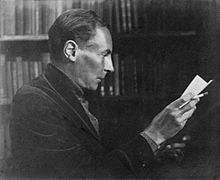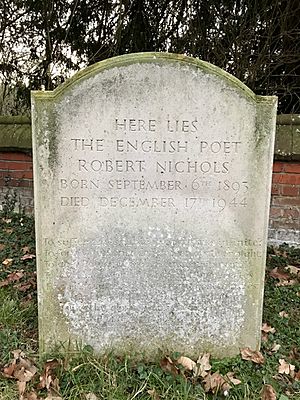Robert Nichols (poet) facts for kids
Quick facts for kids
Robert Nichols
|
|
|---|---|

Robert Nichols (Elliott & Fry, 1930)
|
|
| Born | 6 September 1893 |
| Died | 17 December 1944 (aged 51) |
| Resting place | St Mary's Church, Lawford, Essex |
| Occupation | War poet, playwright |
| Education | Winchester College Trinity College, Oxford |
| Period | First World War |
| Partner | Norah Denny (1922–?) |
| Relatives | John Bowyer Buchanan Nichols (father) |
Robert Malise Bowyer Nichols (born September 6, 1893 – died December 17, 1944) was an English writer. He became famous as a "war poet" because he wrote poems about the First World War. He also wrote plays for the theatre.
Contents
Robert Nichols' Early Life and War Service
Robert Nichols was the son of another poet, John Bowyer Buchanan Nichols. He went to school at Winchester College and then studied at Trinity College, Oxford.
In 1914, Robert joined the Royal Field Artillery, a part of the army. He served on the Western Front during the First World War. He fought in important battles like the Battle of Loos and the Battle of the Somme. In August 1916, he had to return home because he was suffering from what was then called "shell shock," which is now known as PTSD.
Becoming a Poet and Writer
After returning from the war, Robert Nichols started giving poetry readings in 1917. In 1918, he was part of a special British group that went to the USA to share information about the war. He also gave poetry readings there.
One of his most famous war poems is The Assault. This poem describes the terrible destruction and strong feelings of a battlefield attack. It is known for its free and energetic style.
After the war, Robert Nichols became part of London's social scene. He was supported by the writer Edith Sitwell. Aldous Huxley, another famous writer, became his close friend. In 1922, Robert married Norah Denny at St Martin-in-the-Fields church.
From 1921 to 1924, he worked as a Professor of English Literature at the University of Tokyo in Japan. Later, he worked in theatre and cinema. He co-wrote a play called Wings over Europe (1928) with Maurice Browne, which was a big success on Broadway.
Robert Nichols also wrote several stories, including:
- The Smile of the Sphinx: A fantasy story set in the Middle East.
- Golgotha & co.: A funny fantasy story featuring a character called the Wandering Jew, the return of Christ, and a future war.
These stories were later put together in his book called Fantastica.
Later Years and Legacy
In 1933 and 1934, Robert Nichols lived in Germany and Austria. He then moved to the south of France, but he left there in June 1940.
He passed away at the age of 51. He is buried at St Mary's Church, Lawford, Essex, which is next to his family home, Lawford Hall.
On November 11, 1985, Robert Nichols was honored in Westminster Abbey's Poet's Corner. A special stone was placed there to remember him and 15 other Great War poets. The words on the stone were written by another famous war poet, Wilfred Owen. They say: "My subject is War, and the pity of War. The Poetry is in the pity."
Robert Nichols' Published Works
Robert Nichols wrote many books and plays. Here are some of his well-known works:
- Invocation (1915)
- Ardours and Endurances (1917)
- A Faun's Holiday & Poems & Phantasies (1917)
- Sonnets to Aurelia (1920), a collection of poems
- The Smile of the Sphinx (1920)
- Guilty Souls (1922), a play
- Fantastica : being the smile of the Sphinx and other tales of imagination (1923)
- Twenty Below (1926) with Jim Tully
- Under the Yew; or, The Gambler Transformed (1928), a novel
- Wings Over Europe (1928), a play
- Fisbo, or the Looking Glass Loaned (1934), a funny poem aimed at Osbert Lancaster
- A Spanish Triptych (1936), a collection of poems
- Such was My Singing (1942), a selection of his poems. This book also includes parts of a play he never finished called Don Juan Tenorio the Great.
Music Inspired by Robert Nichols' Work
Some composers have used Robert Nichols' poems and plays to create music:
- In 1919, the English composer Kaikhosru Shapurji Sorabji wrote Music to "The Rider by Night".
- Peter Warlock, a close friend of Nichols, set The Full Heart to music for a choir in 1916. He also set The Water Lily as a song in 1922.
- Arthur Bliss, another friend, used Nichols' poems The Naiads' Music and The Pigeon Song in his work Pastoral: (Lie Strewn White Flocks) in 1928. Bliss also used Dawn on the Somme in his large choral symphony Morning Heroes in 1930.
- E. J. Moeran set Blue-eyed Spring for voice and piano in 1932. He also used poems from Nichols' unfinished play Don Juan Tenorio the Great for his piece Nocturne in 1935.
- Christian Darnton set five of Nichols' poems in his 1938 work Swansong, for a singer and orchestra.


